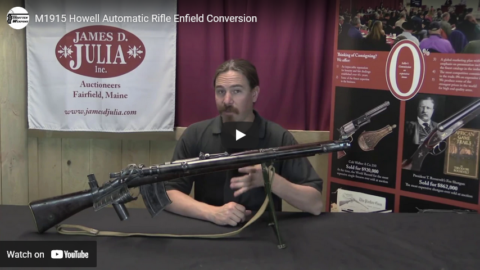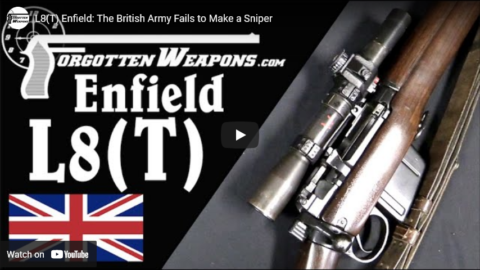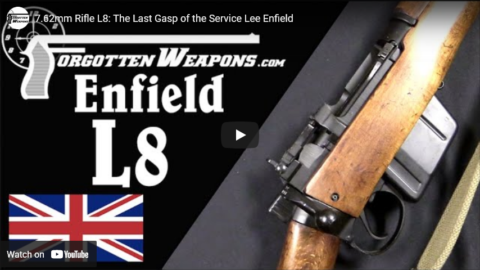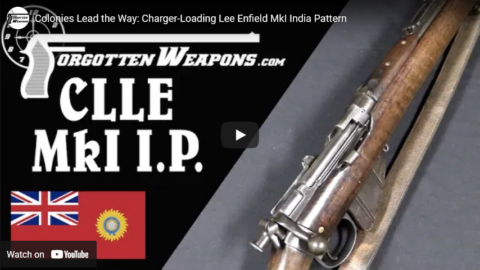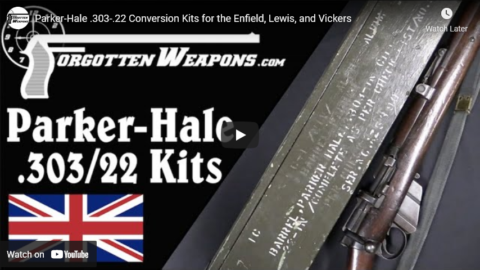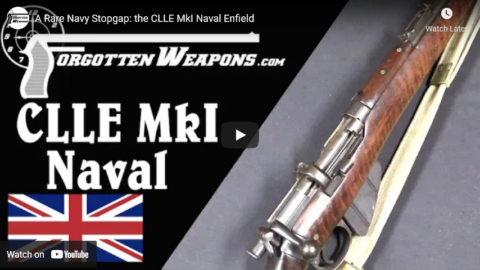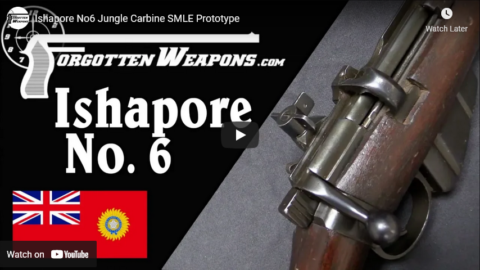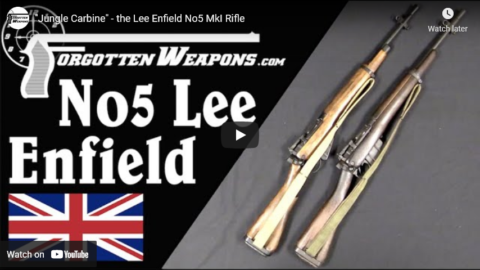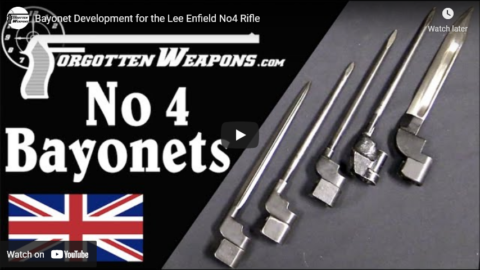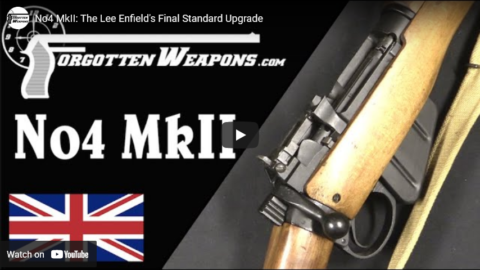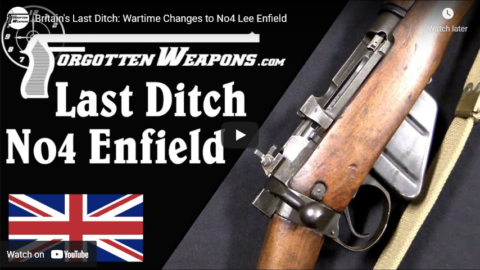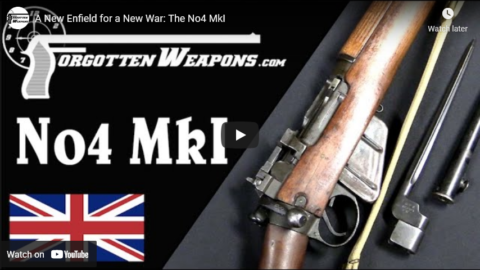Forgotten Weapons
Published 5 Sept 2015The model of 1885 (a modern collector designation; Remington called these the “Remington Magazine Rifle” and did not differentiate between the different versions) was the final iteration of James Paris Lee’s bolt action rifle made by Remington. It incorporated a number of improvements from the earlier versions, including a relocated bolt handle, improved bolt head, and a magazine that could now hold cartridges securely without the use of a sliding catch at the nose.
These rifles were made in .45-70 caliber for US use and in .43 Spanish for export sales. The US Navy purchased most of the .45-70 guns that were made, and this particular rifle is one of those Navy guns. By the time these rifles were actually in production, Great Britain had also decided to adopt the Lee system in 1888, which would go through several iterations and ultimately become the iconic SMLE that would be the mainstay of British infantry during the First World War.
(more…)
July 10, 2023
Remington-Lee Model 1885
March 24, 2023
Operation CARPETBAGGER: French Resistance No4 Enfield
Forgotten Weapons
Published 18 Nov 2022During 1944, the US and UK cooperatively ran a major effort to drop arms and equipment to French Resistance forces in preparation for the Allied landings in France. It began as Operation Carpetbagger with night drops from B24 Liberators in January 1944, and escalated into the summer. Eventually a number of massive daytime drops were made, totally more than 800 sorties and dropping 2.7 million pounds of equipment. The single most common firearm dropped was the MkII Sten, but containers also included Brens, handguns, M1 Carbines, bazookas, and No4 Enfields (along with ammunition).
After the country was liberated, the new government tried to collect up as many of the weapons as possible. They didn’t get them all (not by a long shot, actually), but many were put into government storage, including this No4 Lee Enfield. It was marked with a “PP” property mark and inventory number, and stashed away until being sold as surplus recently and imported by Navy Arms.
(more…)
December 4, 2022
L39A1: British Service Target Rifle Before the L42A1
Forgotten Weapons
Published 5 Aug 2022The story of the conversion of the Lee Enfield to 7.62mm NATO would not be complete without the L39A1. This is essentially the civilian competition version of what would become the L42A1. It was actually in British service as a target rifle — not intended for combat. It followed the L8 (the first British military attempts at a 7.62mm precision version of the Enfield) and the L42A1. It was basically a copy of the conversions done by civilian competition shooters in the British NRA.
Sights were made by several different companies, as the rifles were not issued with sights — they were obtained by the unit they went to, whatever particular model that unit preferred. This example has Parker Hale diopter sights. The L39A1 also used a .303 caliber magazine, as they were intended for slow-fire, single-loaded competition but the magazine was used as a loading tray. The .303 magazine will not reliably hold 7.62mm cartridges, but 7.62mm conversion magazines can be put in the L39A1 and will then work just fine. They also sometimes are fitted with .303 extractors. The stock here has a semi-pistol grip a bit less substantial than the L8 .22 rifle, although most had standard No4 stocks.
The original sights were removed, and remarked as L39A1. They were made in 1969, 1970, and 1972, with a single serial number range used for the L39A1, the pretrial trials examples of the L39, and the “7.62 Conv” rifles. A total of 1,213 L39A1 rifles were made, with the other types accounting for about 28 additional rifles.
(more…)
June 2, 2022
M1915 Howell Automatic Rifle Enfield Conversion
Forgotten Weapons
Published 28 Mar 2017The M1915 Howell Automatic Rifle is a conversion of a standard No1 MkIII Lee Enfield rifle into a semi-automatic, through the addition of a gas piston onto the right side of the barrel. Despite its very steampunk appearance, the Howell is actually a quite simple conversion mechanically. The rifle action had not been modified at all, and a curved plate on the end of the gas piston is used to cycle the bolt up, back, forward, and down just as it would be done manually.
The additional metal elements added to the gun are there to prevent the shooter from inadvertently getting their hand or face in the path of the bolt. The crude tubular pistol grip is necessary because the shooter’s hand on the wrist of the stock would normally be in the path of the bolt’s travel. Note that the Parker-Hale bipod on this example is a non-military addition from its time in private ownership.
In addition to these elements, the Howell has been fitted with a 20-round extended magazine to better exploit its rate of fire. However, the Howell was made as a semiautomatic rifle only, and not fully automatic. It was offered to the British military circa 1915, but never put into service. Instead, the British would significantly increase production and deployment of Lewis light machine guns. Howell would offer his conversion in basically the same form to the military again at the onset of World War 2, but was again turned down.
Shooting the Howell was remarkably successful — I had expected it to be very malfunction-prone, but in fact it ran almost completely without fault. In retrospect, I would attribute this to the simplicity of its conversion, which made no changes to the feeding and extraction/ejection elements of the SMLE. The gun was a bit awkward to hold, and the offset sights left one with really no cheek weld at all, but recoil was gentle thanks to the gas system’s function and added weight. Quite a remarkable gun, and one I am very glad to have been able to shoot.
http://www.patreon.com/ForgottenWeapons
Cool Forgotten Weapons merch, including this shirt specifically about the Howell! https://shop.bbtv.com/collections/for…
If you enjoy Forgotten Weapons, check out its sister channel, InRangeTV! http://www.youtube.com/InRangeTVShow
April 21, 2022
L8(T) Enfield: The British Army Fails to Make a Sniper
Forgotten Weapons
Published 14 Dec 2021http://www.patreon.com/ForgottenWeapons
https://www.floatplane.com/channel/Fo…
Cool Forgotten Weapons merch! http://shop.forgottenweapons.com
We looked at the 7.62mm conversion of the No4 Enfield into Rifle L8 yesterday. Part of that program was an attempt to develop a new sniper rifle on the L8 platform. To this end, six good-quality No4(T) Lee Enfield sniper rifles were tested for accuracy, then made into L8 rifles and fitted with No.32 telescopic sights (the standard scope from the .303 days) and tested for accuracy again. Much to the chagrin of the Army, the new L8(T) rifles were barely able to match the performance of the .303 rifles they began as. The goal was to significantly improve on the No4(T) accuracy, and that was clearly not happening.
However, at this same time, British civilian competition shooters were having excellent success making 7.62mm versions of the No4. It was only when Enfield was willing to collaborate with the British NRA and others that they were able to successfully create the L42A1 rifle, which at last met the accuracy goals of the program.
The rifle we are looking at today is one of those original six trials L8(T) rifles. Many thanks to the generous collector who allowed me to film it for you!
Contact:
Forgotten Weapons
6281 N. Oracle 36270
Tucson, AZ 85740
April 18, 2022
7.62mm Rifle L8: The Last Gasp of the Service Lee Enfield
Forgotten Weapons
Published 13 Dec 2021http://www.patreon.com/ForgottenWeapons
https://www.floatplane.com/channel/Fo…
Cool Forgotten Weapons merch! http://shop.forgottenweapons.com
After the British adopted the FAL as the L1A1 rifle, there was still an interest in converting stocks of existing No4 Enfield rifles to the new 7.62x51mm cartridge for reserve and training use. A conversion system was developed using a new barrel, bolt, and magazine — although the Sterling company was doing much the same thing at the same time and intellectual property lawsuits would close the project for nearly 10 years. By the time the lawsuits cleared up, it had become clear that the rifles were neither particularly successful nor particularly necessary anymore. The problem the British has was one of accuracy — the 7.62mm version just wasn’t sufficiently accurate. A thousand were sold to Sierra Leone, and a few more used in New Zealand and by cadet organizations in the UK, but the project was basically a failure.
Contact:
Forgotten Weapons
6281 N. Oracle 36270
Tucson, AZ 85740
February 3, 2022
Colonies Lead the Way: Charger-Loading Lee Enfield MkI India Pattern
Forgotten Weapons
Published 27 Sep 2021http://www.patreon.com/ForgottenWeapons
https://www.floatplane.com/channel/Fo…
Cool Forgotten Weapons merch! http://shop.forgottenweapons.com
While the Indian Army was looked down upon by much of the British military, it saw much more combat service than its European counterpart. The Indian Army was actually faster than the British to recognize and adopt a number of small arms improvements, and the CLLE MkI India Pattern is a good example.
When the mobile charger guide was first adopted by the British military, no effort was made to retrofit earlier rifles with it. The Indians, however, saw the advantage and began to convert Long Lees to the Charger-Loading configuration as early as 1905. Between then and 1909, some 22,000 of these MkI I.P. rifles were assembled at the Ishapore Arsenal. Following the adoption of the fixed charger bridge, a MkII I.P. became the new standard, with the fixed guide instead of the mobile one.
Contact:
Forgotten Weapons
6281 N. Oracle 36270
Tucson, AZ 85740
January 24, 2022
Parker-Hale .303-.22 Conversion Kits for the Enfield, Lewis, and Vickers
Forgotten Weapons
Published 14 Sep 2021http://www.patreon.com/ForgottenWeapons
https://www.floatplane.com/channel/Fo…
Cool Forgotten Weapons merch! http://shop.forgottenweapons.com
In July of 1918, the British military formally adopted a Parker-Hale system of adapting .303-caliber arms to .22 rimfire for short range training. The system involved lining standard barrels with .22 caliber blanks that were machined with full size .303 chambers. Special cartridge inserts were used which had the external dimensions of .303 cartridges, but held .22LR cartridges inside. This allowed the weapon to use the same feeding system as it normally would, and to duplicate the handling and trigger mechanism of a standard .303 caliber gun while only firing a small rimfire cartridge.
Parker-Hale built kits of this type for the Lee Enfield rifle, the Lewis LMG, and the Vickers HMG, and all were used by the British military. In the Lewis and Vickers, there was no accommodation made to actually cycle the guns; this sort of .22 practice drill was done by manually cycling the actions after each shot. Still, it was a good way to practice basic drill (loading, unloading, etc) as well as basic marksmanship without the noise of full power cartridges and without the need for a full-power-rated backstop.
The system for the Lee Enfield was replaced in 1920 (after only about 2 years of use) with the No2 MkIV* rifle, a dedicated .22 conversion of an SMLE. Parker-Hale kept the system in their commercial catalog into the 1930s, however.
Contact:
Forgotten Weapons
6281 N. Oracle 36270
Tucson, AZ 85740
January 21, 2022
A Rare Navy Stopgap: the CLLE MkI Naval Enfield
Forgotten Weapons
Published 6 Sep 2021http://www.patreon.com/ForgottenWeapons
https://www.floatplane.com/channel/Fo…
Cool Forgotten Weapons merch! http://shop.forgottenweapons.com
The British Royal Navy tended to accumulate some of the obsolescent patterns of Enfield rifles around the turn of the 19th century, as the Army had higher priority for the new types of rifle. This resulted in a rather odd and poorly-documented pattern, the Charger-Loading Lee Enfield (CLLE) MkI Naval.
Produced around 1910-1912, these guns began as original production Long Lee (or Metford) rifles. In 1910, the new MkVII high velocity Spitzer ammunition was adopted, and it was largely issued on charger clips for use in the new SMLE rifles. The Royal Navy decided that it wanted to be able to use this ammunition, and so it converted some (exact numbers are unclear) of the old Long Lees with a mishmash of updates.
The rear sights were recalibrated for MkVII ammunition, but not changed in style. So, no windage adjustment was possible on either the front or rear.
A charger bridge was added, including a channel cut to allow a sight picture on the old-style sights. This also involved removing the early pattern dust covers on the bolts.
The resulting guns were marked “HV” for “high velocity” in front of their rear sights. The right side of the receiver socket retained the original production markings, and “CLLE MkI” was added to the left side of the sockets.
Contact:
Forgotten Weapons
6281 N. Oracle 36270
Tucson, AZ 85740
January 18, 2022
Ishapore No6 Jungle Carbine SMLE Prototype
Forgotten Weapons
Published 21 Nov 2018https://www.forgottenweapons.com/isha…
http://www.patreon.com/ForgottenWeapons
Cool Forgotten Weapons merch! http://shop.bbtv.com/collections/forg…
In 1943, the British government began a program to develop a shortened and lightened version of the No1 SMLE rifle, for production in India and Australia — where the national ordnance factories had not converted to production of the No4 rifle. This prototype is the first pattern produced by the Ishapore Arsenal for testing. Its barrel is cut down to 16.5 inches (plus a 2.8 inch long conical flash hider), it has a unique 3-position flag style of rear aperture sight, and has had its sling swivels repositioned. This rifle was tested in the UK, and some modifications were recommended. A second pattern from Ishapore was then provisionally approved as the No6 MkI on September 1st, 1944, but cancelled before production could begin. The Australian pattern of No6 was approved a year late in September 1945, but then declared obsolete before it could be put into production. With the end of World War Two and Indian independence in 1947, the funding and impetus for a new short rifle were lost, and instead Ishapore would end up converting its production to No1 pattern rifles in 7.62mm NATO a few years later.
Contact:
Forgotten Weapons
PO Box 87647
Tucson, AZ 85754
November 14, 2021
“Jungle Carbine” – the Lee Enfield No5 MkI Rifle
Forgotten Weapons
Published 4 Aug 2021http://www.patreon.com/ForgottenWeapons
https://www.floatplane.com/channel/Fo…
Cool Forgotten Weapons merch! http://shop.forgottenweapons.com
Today I am concluding our series on the standard-issue Lee Enfield system with the No5 MkI — the “jungle carbine”. Developed in 1943 as a shorter and handier pattern of rifle than the No4, the carbine went into production in 1944 and saw use during World War Two. It featured a number of lightening cuts, as well as a shortened barrel, conical flash hider, side-mounted sling, 800-yard sights, and rubber buttpad. Unfortunately, the No5 was beset by a problem of “wandering zero”. A significant number of the rifles failed to properly hold zero when they were widely issued. The problem was never fully resolved, but appears to have been the result of receiver flex due to the lightening cuts. Efforts to fix it were essentially abandoned, as it was recognized that a new self-loading rifle was going to be adopted soon, and it would be a waste of time and money to continue development of the Lee Enfield by that point.
Contact:
Forgotten Weapons
6281 N. Oracle 36270
Tucson, AZ 85740
November 9, 2021
Bayonet Development for the Lee Enfield No4 Rifle
Forgotten Weapons
Published 22 Jul 2021http://www.patreon.com/ForgottenWeapons
https://www.floatplane.com/channel/Fo…
Cool Forgotten Weapons merch! http://shop.forgottenweapons.com
Having wrapped up our series on the major development of the Lee Enfield rifle in British service, I figured it would be a nice addendum to talk about the bayonets developed for the No4 rifle. These went through a substantial evolution, and are an interesting field for collectors all by themselves.
During World War One, the British used the Pattern 1907 bayonet, a long blade type essentially copied from the Japanese Type 30. By the 1920s, this was being reconsidered – the long blades were expensive, fragile, and perhaps not really necessary. When the No1 Mk VI rifle was put into trials, it was given a new bayonet style. This was inspired by the Swiss cyclists’ bayonet, with a cruciform spike instead of a true blade. It was only 8 inches long; this was determined to be long enough for virtually all use cases and being short minimized weight and bulk.
As World War Two progressed, the spike bayonet was simplified several times. Before the initial production of the first standard model (No4 MkI) was completed, the cruciform pattens had already been abandoned for a much simpler (and faster and cheaper) round body spike with a screwdriver-like point at the end. This was in turn simplified by separating the socket and spike into two parts for easier production, and then further simplified by casting the socket instead of forging it. After the war, the spike was replaced by a short blade-type socket bayonet (the No9), although this was rather short-lived because of the adoption of the SLR (FN FAL).
Contact:
Forgotten Weapons
6281 N. Oracle 36270
Tucson, AZ 85740
November 6, 2021
No4 MkII: The Lee Enfield’s Final Standard Upgrade
Forgotten Weapons
Published 21 Jul 2021http://www.patreon.com/ForgottenWeapons
https://www.floatplane.com/channel/Fo…
Cool Forgotten Weapons merch! http://shop.forgottenweapons.com
The final standard pattern of the venerable Lee Enfield as a standard-issue service rifle was the No4 MkII, introduced after the end of World War Two. The new pattern was adopted to resolve problems that had come about because of wartime simplifications to the rifle. Specifically, the use of kiln-dried wood for stocks. On the original No4 design, the trigger was pinned to the trigger guard, which was in turn connected to the front handguard. The sear was pinned to the receiver. If the handguard swelled, shrank, or warped (which was much more likely on the quickly kiln-dried stocks used during the war, compared to the naturally dried pre-war wood), the trigger/sear interaction could be impacted.
To solve this, the receiver was changed slightly to include a boss for attaching the trigger. This kept both the trigger and sear pinned to the (metal) receiver, and stock shifting was no longer a problem. In addition, a change was also made to remove the boss originally intended for mounting the magazine cutoff lever, so that No4 rifles would be made using No5 receiver forgings (this change did not result in a new rifle designation).
Many existing rifles were refitted to the new standard, with upgraded MkI rifles becoming Mk I/2 and upgraded MkI* rifles becoming MkI/3.
Contact:
Forgotten Weapons
6281 N. Oracle 36270
Tucson, AZ 85740
November 1, 2021
Britain’s Last Ditch: Wartime Changes to No4 Lee Enfield
Forgotten Weapons
Published 14 Jul 2021http://www.patreon.com/ForgottenWeapons
https://www.floatplane.com/channel/Fo…
Cool Forgotten Weapons merch! http://shop.forgottenweapons.com
When we think of “last-ditch” rifles, we normally think of 1945 and the very end of World War Two. For the British, however, the lowest ebb of the war was in 1941 and 42, and it is during that period that the Lee Enfield was at its crudest. British ordnance instituted a number of simplifications to maximize weapons production. In particular:
– Walnut replaced with kiln-dried birch and beech for furniture
– Two-groove barrels replacing five-groove ones
– A vastly simplified 2-position flip sight in place of the original fine micrometer style
– Simplified bolt release, designated the No4 MkI* (which was only produced in the US and Canada)
– Aluminum buttplates
– Much reduced standards of fit and finish, leading to really ugly machine marks and haphazard markings.Most of these changes would be walked back later in the war as Britain’s footing became more solid, but they make a very interesting period of changes for the collector to study.
Contact:
Forgotten Weapons
6281 N. Oracle 36270
Tucson, AZ 85740
October 29, 2021
A New Enfield for a New War: The No4 MkI
Forgotten Weapons
Published 7 Jul 2021http://www.patreon.com/ForgottenWeapons
https://www.floatplane.com/channel/Fo…
Cool Forgotten Weapons merch! http://shop.forgottenweapons.com
The stalwart No1 MkIII “Smelly” served the United Kingdom well during the First World War, but by the 1920s it was growing obsolescent. The war had revealed a number of shortcomings of the design, and in the interwar years the British developed a replacement. The main issues that the new rifle would address were:
– Better mechanical accuracy, through use of a heavier barrel
– Better practical accuracy, through use of a micrometer-adjustable aperture sight
– A more practical short spike bayonet
– More efficient manufacturabilityAfter a brief dalliance with the No1 MkV rifle in the early 1920s, the No1 MkVI was developed, which was fundamentally the new No4 rifle, just without the name. In the early 1930s a run of about 2500 No4 MkI rifles was produced, and they would go through field trials for the next several years until being formally adopted in 1939. Production actually began in the summer of 1941 at Maltby, Fazakerley, and BSA.
Contact:
Forgotten Weapons
6281 N. Oracle 36270
Tucson, AZ 85740

